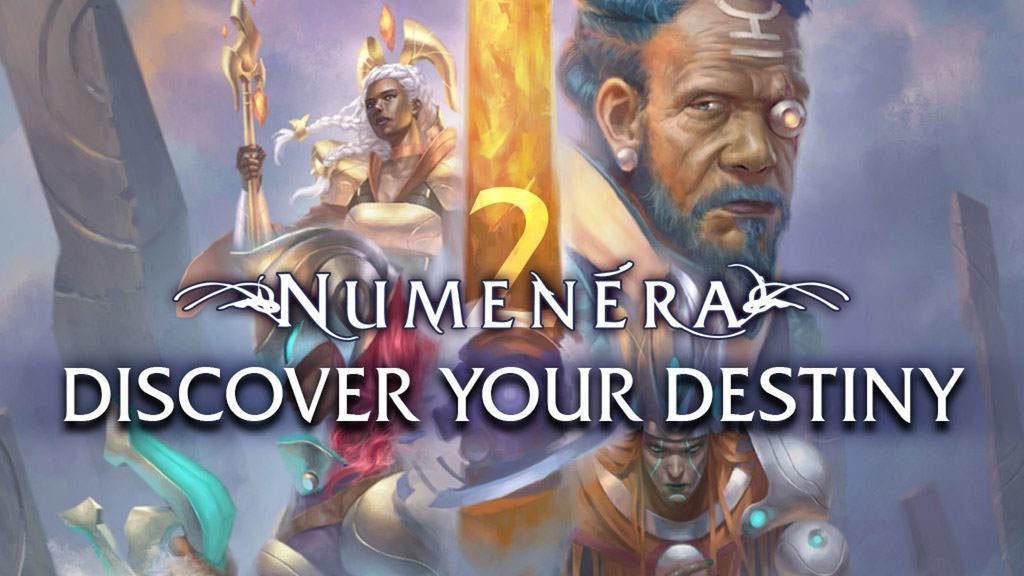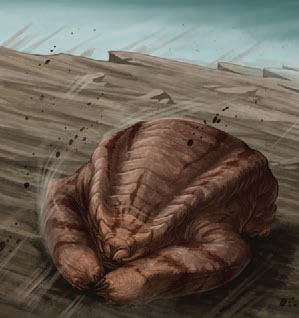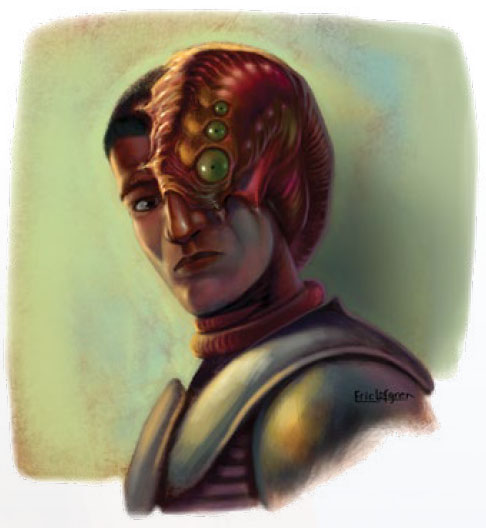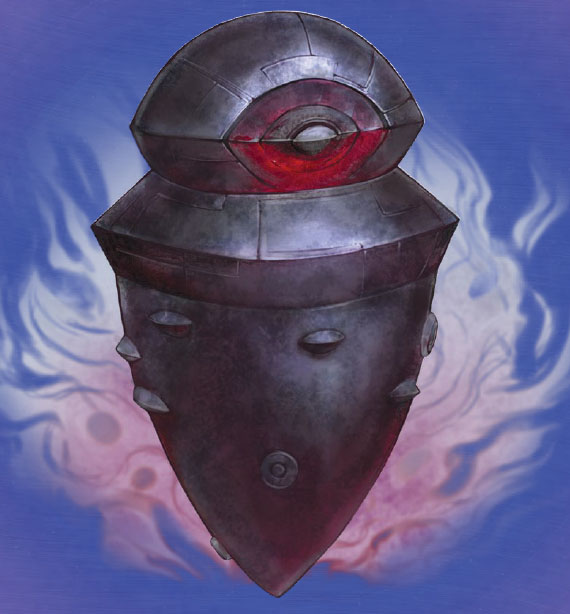
Numenera 2: Discovery and Destiny, the second edition of the game making the exciting promise of expanding its core gameplay to include developing local communities and rebuilding civilization in the ruins of the past worlds, is just around the corner.
One response that I’ve seen frequently to Numenera from GMs is that they can’t quite wrap their head around the setting: The core rulebook uses a combination of techniques for presenting the Ninth World, and for many people one or more of those techniques clicks. For others, they don’t. Or, worse yet, the combination of techniques is baffling in its own right. So what I’d like to do here is to focus on just one way of approaching the Ninth World. It’s not one that gets much attention in the core rulebook, so it might work for those who couldn’t find anything to latch onto in the core rulebook, and the focus on just one angle of approach might also be useful for those who find the totality of the Ninth World just a little too much to take in all at once.
Perhaps more importantly, as a GM I’ve found this particular angle — which I’m going to refer to as the Aldeia Approach — to be specifically valuable when it comes to creating cool scenarios for the setting. It’s kind of like a “default action” for the GM: The setting is capable of doing all kinds of other cool stuff, but if you’re ever at a loss for what to do next (or what your first step with Numenera should be), the Aldeia Approach will faithfully serve up something you can use.
A FEW BASICS
Before we dive into the Aldeia Approach, a few general words on grokking the Numenera setting.
First, it’s not a bad idea to read some of the fiction that Monte Cook cites as the primary influence for the game. Not just because it will help you tune into the milieu, but because it’s all really fantastic fiction that you should read in any case. I would direct your particular attention to:
- The Book of the New Sun by Gene Wolfe
- The Dying Earth by Jack Vance
- Dune by Frank Herbert
- Eternals and New Gods by Jack Kirby
- The Zothique Cycle by Clarke Ashton Smith
- Nausicaa of the Valley of the Wind by Hayao Miyazaki
Second, pay attention to how Cook has structured the setting to make it accessible to newcomers (particularly new players): The core of the setting described in the core rulebook is the Steadfast, where a Renaissance movement is reclaiming the lost technology of past civilizations the same way that Western Europe reclaimed the science and technology from Ancient Greece and Rome. The Steadfast very specifically resembles the real world Renaissance in both culture and civilization so that you can easily latch onto it as an entrypoint into the world.
As you move beyond that entry point — into an area of world literally referred to as the “Beyond” by residents of the Steadfast — you begin encountering larger and larger amounts of the weird. Exploring the Beyond is really the point where you start dipping your toes into the truly exotic bizarrity which the Ninth World can be. As you move even farther out into the world, you’ll start encountering the truly alien aspects of the Ninth World.
I’ve seen a number of people complain that the setting (by which they really just mean the Steadfast) is just “D&D with a patina of science fiction”. That’s not really true, because the Ninth World is fundamentally different from D&D. But it is true that both D&D and Numenera use a heavily fictionalized version of the Renaissance as a common starting point to provide something that’s easy-to-run and easy-to-understand. And you can, in fact, have entire glorious campaigns solely within the comfortable confines of the Steadfast. Nothing wrong with that. But there’s also nothing wrong with skipping the Steadfast entirely and jumping straight into the more outrageous aspects of what the Ninth World has to offer.
THE ALDEIA APPROACH
The word aldeia is another name for “village” in the Steadfast and the Beyond, and buried away in one obscure corner of the core rulebook is this text:
Around these claves [of Aeon Priests], small villages and communities known as aldeia have arisen. Each clave has discovered and mastered various bits of the numenera, giving every aldeia a distinct identity. In one, the inhabitants might raise unique bioengineered beasts for food. In another, people may pilot gravity-defying gliders and race along the rooftops of ancient ruins. In still another aldeia, the priests of the clave may have developed the means to stop the aging process almost entirely, making the residents nearly immortal, and some are no doubt willing to sell the secret — for a staggering price. Because the aldeia are remote and separated by dangerous distances, trade of these discoveries is occasional and haphazard.
So communities often have some form of numenera that they’re capable of exploiting. But that construction can also be inverted: Aldeia arise because there is an exploitable form of numenera in a particular region. They’re like technological mining towns; communities growing up around an economic resource.
And the Aldeia Approach basically latches onto that concept: If you’re wondering what to do with Numenera, you can’t go too far wrong by looking for an artifact or cypher and then asking, “What happens if an entire community is based around this?” In my experience, at least one (and usually several) playable scenario hooks will become obvious as you’re answering that question.
In terms of introducing the setting and building its complexity over time (for both the GM and the players), the Aldeia Approach is also an ideal way to launch a campaign: Frame the PCs as some form of itinerant wanderers, and simply have them encounter interesting aldeia in the course of their travels. When you feel like you’re starting to get a grip on things, move up to a small regional town: Such towns would be based around trade with several smaller aldeia, so list a half dozen or so prevalent numenera technologies the city has access to and think about what the resulting town looks like. (Maybe you even run an urbancrawl there.)
The Aldeia Approach is so robust that you can practically randomize it. For example, let’s combine the random numenera tables from Sir Arthour’s Guide to the Numenera (you could just as easily use the tables from the core rulebook alone) with S. John Ross’ Big List of RPG Plots (which I’ll just use in order for the sake of argument) and see what we end up with.
GOLD ‘NADO
Deployer (Atmospheric): “The device collects the most widely available atmospheric aerosols within long range (such as drit dust, water droplets, pollen, bacteria, or smoke). It brings these aerosols together in a whirling tornado that centers around the device itself.” An aldeia has figured out how to reverse engineer a deployer and produce them in a bespoke industry. In combination  with specially designed filters, they’re used to mine surface gold. (Or perhaps something more exotic?) Combine with Any Port in the Storm: An unforeseen interaction between the deployers cause their “prospecting ‘nados” to collapse into a single, massive tornado which now threatens the aldeia. (Maybe this even happens with some regularity and the aldeia has gotten used to “battening down the hatches” when it happens?) The PCs are forced to take refuge… but the real danger is in whatever location they’ve taken refuge in.
with specially designed filters, they’re used to mine surface gold. (Or perhaps something more exotic?) Combine with Any Port in the Storm: An unforeseen interaction between the deployers cause their “prospecting ‘nados” to collapse into a single, massive tornado which now threatens the aldeia. (Maybe this even happens with some regularity and the aldeia has gotten used to “battening down the hatches” when it happens?) The PCs are forced to take refuge… but the real danger is in whatever location they’ve taken refuge in.
The threat could be human in nature (a serial killer in a locked up inn, perhaps). But let’s pick a random page from the Ninth World Bestiary and see if we can end up with a threat: “A skysmasher arrives as a red blaze across the sky, leaving a trail of light and smoke. (…) Skysmashers live out most of their span in some useable above the sky, crashing down to solid groun only to spawn and lay eggs.” What if the skysmasher crash actually triggered the malfunction in the prospecting ‘nados? What if its eggs hatch very quickly after being brought to earth and begin trying to breach the PCs’ sanctuary?
THE KINGDOM’S HELM
Ocular Helm: “The wearer of this strange helm sees a variety of visual sensors, clarity enhancers, viewfinders, rangefinders, and other aids to sight.” Let’s say that there’s a great lake which is perpetually covered in a strange, silver-green mist. Navigating through this mist has proven virtually impossible using traditional means, but a set of island kingdoms within the mist control a limited number of ocular helms. The Elite Order of Helmsmen are charged with navigating the lake, guaranteeing  the security and prosperity of the islands. Better Late Than Never: Someone has stolen one of the ocular helms. The PCs are hired to track them down (or maybe there’s just a bounty and a bunch of people are trying to find it).
the security and prosperity of the islands. Better Late Than Never: Someone has stolen one of the ocular helms. The PCs are hired to track them down (or maybe there’s just a bounty and a bunch of people are trying to find it).
Another option: The PCs find an ocular helm in the course of some other adventure (probably while exploring some mouldering ruins). When the island kingdoms receive word of this, they can’t let the PCs keep it. It’s a huge security risk! But even if (some) of the kingdoms are willing to just make a generous offer, there are other factions in play that will just try to steal it from the PCs.
And another: Some strange technophage has destroyed the ocular helms controlled by the Elite Order. The kingdoms desperately need to secure another: Cue a heist in the great city of Qi, or maybe just a treasure hunt in pursuit of ancient rumors.
EXACTION EXHALATION
So I initially roll up Device Enhancer (Restorer), a cypher which can be attached to a different cypher or artifact and that device now restores a total of 4 points each time it is activated (in addition to its normal function) or 2 additional points if the device already restores points. So I roll again and I get Exalted Vapor,  which allows the user to inhale a potent chemical that restores 6 points to any pool. So what we end up with is a vapor which restores 8 points of Might when inhaled.
which allows the user to inhale a potent chemical that restores 6 points to any pool. So what we end up with is a vapor which restores 8 points of Might when inhaled.
Let’s go with the obvious: A secluded village where special sauna chambers filled with strange vapors restore the afflicted to health. The exalted vapor cyphers that are placed in these chambers are created by a set of ancient machines held in caverns deep beneath the village.
Combine this with Blackmail: When the PCs arrive in the village, they are surprised to see it clutched by poverty and hardship. The wealth flowing into the saunas seems to just vanish into the vapor. Poking around, they discover that a murden has stolen a crucial numenera artifact which creates one of the reagents required for the exalted vapor. The murden is blackmailing the town into crippling payments and is threatening to destroy the irreplaceable device if they don’t comply.












As always thanks for the brilliant article. I have to admit I think it helped that I had read some of fiction reference by Monte, it made it easier to see what was trying to be done with the world. I’m still trying to find the right way to describe Numenera to other people, I find that people either get it or don’t. I’ve used a similar method to what you described here; I find a piece of Numenera or something strange and base a place around it. The first place my players explored was Pikeshead and the beast.
The link under “The Kingdom’s Helm” is broken.
Can’t wait to check out your urban crawl series. Considered using Ptolus for Qi.
The Link to Ross’s Big List of RPG Plots no long works. Here is a functioning link:
https://web.archive.org/web/20110902100434/http://www222.pair.com/sjohn/blueroom/plots.htm
The Link to Ross’s Big List of RPG Plots no long works. S. John Ross changed his blog to the following site:
https://rolltop-indigo.blogspot.com/2018/10/the-big-list-of-rpg-plots.html